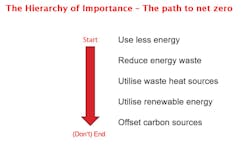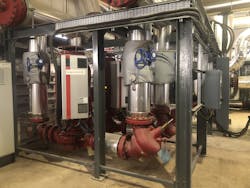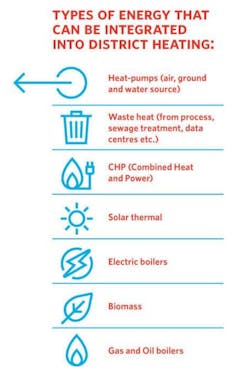For decades now, district energy networks have been successfully deployed around the world and have been shown to be a proven method of providing heat to multiple properties, even while reducing carbon emissions.
Globally, there are many examples of municipalities and business districts reporting substantial energy savings and dramatic reductions in their carbon footprint. The district heating and cooling networks in North America are on a more modest scale and tend to be located in university and hospital campuses. However, that could soon be changing, as an even greater variety of renewable energy sources come available and the concept of sector coupling further increases available energy.
Hierarchy of importance
One helpful approach to building an understanding of efficiency in district systems is to construct a hierarchy of importance and use comparative returns in energy reduction as a decision tool. The first stage, and the easiest way to reduce our carbon emissions, of course, is to simply use less energy.
This means making buildings more air-tight, using more insulation and reducing water use. When the opportunities at that stage have been exhausted, and a stage of diminishing returns is reached, we can move on to the next step in the progression -- reducing energy waste by making systems more efficient.
But waste that can’t be reduced, such as from industrial processes, for example, needs to be utilized. So, we also need to examine opportunities for using waste heat sources. With that in mind, as much as possible, sources of energy should be both renewable and as diverse as possible. The diversification of energy sources gives rise to greater security and increased flexibility in our energy supply. Finally, any carbon that is emitted, should be offset.
What is a district energy system?
A factsheet published by the U.S. Dept. of Energy provides a helpful answer: “District energy systems are characterized by one or more central plants producing hot water, steam, and/or chilled water, which then flows through a network of insulated pipes to provide hot water, space heating, and/or air conditioning for nearby buildings. District energy systems serve a variety of end-use markets, including downtowns (central business districts), college and university campuses, hospitals and healthcare facilities, airports, military bases, and industrial complexes. By combining loads for multiple buildings, district energy systems create economies of scale that help reduce energy costs and enable the use of high-efficiency technologies such as combined heat and power (CHP).”
What is a central plant system?
A central plant system is simply a building with heating, domestic hot water, possibly a cooling load and an energy center located within the building. But to think of a building in this way can limit its future potential.
The network of low temperature hot water (LTHW) and/or chilled water pipework should be optimized to maximize delta T and efficiency. The control and heat emitters should be sized such that the flow and return temperatures future-proof the building and allow it to be connected to district networks at some point in the future. In this way, it can be helpful to think of a central plant building as district heating (or cooling), vertically.
Central plant buildings are the precursor to more ‘traditional', horizontal district heating or cooling systems. They allow for easier connection to the district networks as soon as the pipework comes close to the building. In this way, they facilitate the organic growth of heating and cooling networks, speeding up their expansion and the benefits of the amalgamation of demand and the increased utilization of renewable and waste heat sources.
Traditional heat networks will normally consist of various building types -- residential, commercial, industrial -- connected by a large network of pipes. Systems can include a number of energy centers, storage facilities and waste heat capture stations connected to a single network.
Notably, the variety of building types served by a network has the effect of smoothing the peaks and troughs of demand. This creates a more stable and higher base load that allows for the improved utilization of renewable sources. Together, the waste heat and renewable energy sources take a greater share of the load.
If higher carbon-emitting sources are required, their use is minimized and is restricted to times when the combination of the energy from waste, renewable sources and the stored energy cannot meet the short-term peak demands.
District heating systems
District heating systems are energy source-agnostic and allow for multiple energy sources, sometimes even on the same network. This means district heating both increases the resilience of heat supply and creates opportunities for building owners, councils, towns and cities to reduce carbon emissions. Ways in which district energy systems provide out-sized value include:
- Variety of energy sources allow for the productive use of waste heat;
- They significantly reduce carbon emissions, while increasing resilience and reliability;
- They future-proof the supply of heating and domestic hot water (DHW) and support reduction of carbon emissions to multiple end-users;
- They remove reliance on traditional fossil fuels and increase available practical energy sources;
- They reduce the pronounced peaks and troughs of individual demand, thereby allowing greater renewable utilization within the energy supply;
- They serve as a gateway technology for sector coupling. Waste heat from various sources can be utilized in the heat network.
District heating and thermal storage go hand in hand. Thermal storage allows even greater utilization of waste heat and renewable sources despite changes in the demand profile.
District cooling systems
District cooling systems use similar designs, but supply chilled water instead of heating or domestic hot water. The chilled water is typically generated via chillers or cooling towers. It is then typically sent through fan coil units within the building to cool the air during periods of high ambient temperatures.
The equipment required in cooling networks along with the benefits of the district approach are the same for cooling as they are for heating. Amalgamating the cooling loads reduces demand peaks and allows for greater utilization of renewable cooling sources, such as the free cooling that may be available from a nearby lake or river.
District cooling also reduces the ‘heat island’ effect of multiple individual air conditioning units. Waste heat from these individual AC units contributes to the higher ambient temperatures seen in most cities with high individual AC unit use. District cooling plants can be located remotely from residential dwellings, so the heat island effect is removed.
Generally, for cooling, the capacities, in terms of both power and flow tend to be greater on cooling applications than heating applications.
Flow levels are generally higher, due to the much smaller delta T associated with cooling circuits. In heating applications, delta T values of 20 to 40 deg. C are common. In chilled-water applications, delta T values of 8 to 10 deg. C are typical. This much lower delta T dictates higher volume flow rates for a given power output.
The result is larger plate heat exchangers, pipes and pumps. The component types and hydraulic layout remain the same, but the sizes are generally larger. Due to the likelihood of condensation, pipework, valves, PHE’s and all associated equipment installed on the chilled network needs to be vapor-sealed. So it is common to see drip trays and condensation drains on the fan coil units.
Sector coupling v. hard electrification
As we start to think about sector coupling, these large networks can be thought of as large energy stores that can facilitate the energy flow into and out of buildings. They also allow for energy to be transferred to and from the district heating and cooling networks via bridging facilities such as data centers, and large-scale heat pumps and absorption heat pumps (heat to cool, cool to heat).
A 2018 report from the European Parliament Committee on Industry, Research and Energy noted that the ‘hard electrification’ of our energy supply is problematic and may actually be restrictive in achieving our carbon reduction goals. The report also indicated that district energy systems and sector coupling would help with the decarbonization process, increase flexibility of energy supply and improve reliability. It recommended focusing on sector coupling rather than hard electrification.
Sector coupling allows energy to be utilized in various forms, regardless of changing demands and changing outputs during a typical 24-hour period. Key advantages include:
- Leveraging combinations of commercial, industrial and domestic sectors;
- Leveraging aspects of a network to optimize energy sources, storage, conversion and utilization;
- Energy distribution across a network;
- Use and prioritization of waste heat sources;
- The potential for storage of energy in a formats such as LTHW, electric batteries, hydrogen;
- Use of low or zero carbon sources, such as wind, solar;
- Allowing end users to feed energy back into the network.
With these advantages to bolster the effectiveness and efficiency of a network, opportunities for sector coupling must be seriously considered, wherever available.
Comparing benefits per stakeholder
The Combined Heat and Power Technology Fact Sheet, published by the U.S. Dept. of Energy, provides an excellent summary of the benefits, broken out by stakeholder.
Benefits to Customers
• Higher energy efficiency • Lower building costs (no separate boilers, chillers, or other related hardware) • Easier building operation and maintenance • Enhanced building aesthetics and comfort (reduced noise and vibration) • Improved reliability (industrial-grade district energy equipment is more robust than commercial equipment installed at building level).
Benefits to Cities and Communities
• Reduced first cost for new development • Flexibility in use of fuel sources, including local or regional fuel sources (wood waste, biomass, waste heat, etc.) that keep energy dollars recirculating in local economy • Architectural and aesthetic advantages, with roofs free of mechanical equipment • Grey water/treated sewage effluent usable for condenser water (owing to central plant scale), conserving potable water for consumption • Capacity to provide baseload power and heat for microgrids, enhancing resilience and reducing regional greenhouse gas emissions.
Benefits to Grid Infrastructure
• Reduced peak demand (enabled by aggregating loads and shifting peak demand with thermal energy storage) • Fewer natural gas peaking stations • Lower transmission and distribution costs.
Benefits to the Environment
• Reduced air emissions, including greenhouse gases, as a result of greater fuel efficiency of district energy systems that include CHP • Increased adoption of renewable energy sources at scale, replacing higher-emitting central station generation with low- and zero-emitting technologies • Improved stormwater management owing to free roof space, which can be used for low-impact storm water management strategies and mitigation of excessive runoff.
How to get started
Despite the clear benefits of district energy systems, the scale of construction and the number of stakeholders involved make these projects seem too difficult to complete or even start. Resources are available to help planners better understand the technology and the possibilities for energy savings and sustainability gains. A few of the most prominent are listed here:
Local Governments for Sustainability is a global network of more than 2,500 local and regional governments committed to sustainable urban development. The organization holds online ‘energy exchange’ events, meant to provide light-touch technical assistance to dedicated cities and regions undertaking their sustainable energy transition. The events are recorded and archived at: https://renewablesroadmap.iclei.org/energy-exchanges/
The District Energy In Cities Initiative is a multi-stakeholder partnership coordinated by the United Nations Environment Program. The initiative supports local and national governments by facilitating learning and advocating for policies that will accelerate investment in low-carbon and climate-resilient district energy systems. Through a network of contributing partners, including municipal, national and state governments, utilities, industry associations, and research institutions and universities, the initiative provides neutral and comprehensive advice based on international best practices.
The International District Energy Association hosts webinars and conferences, prepares whitepapers and case studies and publishes a quarterly magazine. The association also maintains an active web site of resources including a Product and Services Directory designed to help identify industry partners for District Energy projects.
###
Based in the United Kingdom, the author has more than 30 years of experience in engineering, manufacturing and HVAC system design, with diverse roles covering product management, technical training, lecturing and sales. Since 2006, his focus has been within the district energy market, specializing in network and energy center design and renewable energy source integration. Email: [email protected].
About the Author
Neil Parry
Global Head of District Energy - Armstrong Fluid Technology
Based in the United Kingdom, the author has more than 30 years of experience in engineering, manufacturing and HVAC system design, with diverse roles covering product management, technical training, lecturing and sales. Since 2006, his focus has been within the district energy market, specializing in network and energy center design and renewable energy source integration.



